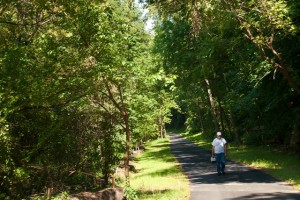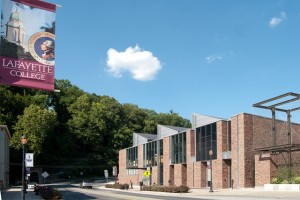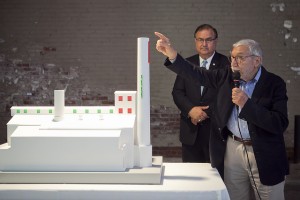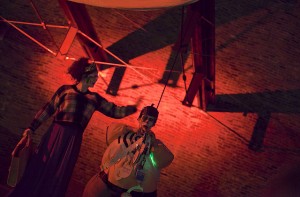
A resident takes a walk on the new Karl Stirner Arts Trail.
The new Karl Stirner Arts Trail wends along the Bushkill Creek, past cascades, towering sycamores, a meadow, and a stone wall that was built as a public works project during the Great Depression. Named for the renowned sculptor and Easton arts pioneer, the 2.5-mile stretch is set to officially open at the end of September.
The path runs from the Simon Silk Mill on 13th Street to Lafayette’s new Williams Arts Campus on North Third Street before continuing through Centre Square and then to the banks of the mighty Delaware River. It will feature numerous art installations and the city’s first dog park.
“It’s an eastern river walk,” says Ed Kerns, Eugene H. Clapp II Professor of Art and vice chair of the committee tasked with selecting the outdoor sculpture. “You know that place in Austin? That’s nice, but this is fantastic.”
One of three projects funded by a state grant that Easton and Lafayette received in 2004 to revitalize the Bushkill Creek Corridor, the trail is a key element in transforming the city’s once-industrial landscape into a haven for culture and recreation. The projects also help reinforce the goal in the College’s strategic plan to make programs in the creative arts an essential feature of campus culture.

The Williams Visual Arts Building serves as the anchor for the College's new Williams Arts Campus on North Third Street.
The other two projects that received funding include an expansion of Lafayette’s arts campus at the base of the College and redevelopment of the long-shuttered silk mill into an arts complex with lofts and studios for artists, galleries, shops, and a boutique hotel. Read more about the Williams Arts Campus.
“We have an opportunity to tie all of this together with public art in ways the city has never seen,” says Becky Bradley, Easton’s director of planning and codes. “When all of this gets done, it’s going to be huge.”
Chad Helmer of Taggart & Associates Inc., the Bethlehem consulting firm overseeing development of the Bushkill Creek Corridor for the Easton Redevelopment Authority, says contractors are in the process of installing five concrete pads along the trail to anchor large pieces of sculpture.
“Those are primarily for really big pieces, but there are lots of opportunities for smaller-scale art,” he says.
Kerns, who co-chairs the Bushkill Creek Corridor Council of the Arts with Jim Toia, director of the College’s Community-Based Teaching Program, says some of the sculptures will rotate so the displays don’t get stale. That way, visitors will continually have a new experience each time they traverse the path.

Easton mayor Sal Panto and artist Stephen Antonakos unveil the artistic vision for the main building of the Silk Mill project.
“What a place to run, jog, walk, and bike while interfacing with the creek,” he says. “It’s an urban park.”
When the idea for a trail began several years ago, the public’s priority was that it be a fully operational bike path with a flat grade suitable for wheelchairs and strollers, says Bradley. It more than fulfills that aim.
“It is a completely hard surface the whole way through, but offers two different experiences: a naturalized one along the Bushkill and then an urban one through the city,” says Bradley.
To accomplish that, the city repaired some of the sidewalks that run from North Third Street to Centre Square and installed pedestrian timers at crosswalks to create a more friendly and safe experience. It ends — or begins, depending on the direction of travel — at Scott Park on Riverside Drive.
A component of the Bushkill Creek Corridor project, the trail allows unprecedented access to Easton’s portion of the waterway, a beautiful trout-supporting stream largely neglected by the city populace.
Kerns calls the trail a “game changer” for the city and College, saying it has the potential – along with the arts campus and silk mill project – to elevate the area’s reputation as an arts destination to the highest level of national recognition.
While redevelopment of the entire 330,000-square-foot silk mill may take decades, the first phase is underway and VM Development Group has signed on as developer. The Flemington, N.J., developer is no stranger to Easton. The firm has renovated the Pomeroy Building and purchased the National Building for office space. The contract to demolish one of the newer garage buildings has just been awarded. “That will create access to the interior portion of the site,” says Helmer.

College Theater's production Ubu Roi at the arts plaza in the new Williams Arts Campus.
The first piece of art showcased at the mill will be a neon sculpture by international artist Stephen Antonakos. Installed on the side of a smoke stack, it will be on 24 hours a day and serve as a beacon for the city and project.
In the meantime, design of Lafayette’s expanded arts campus is underway, with construction of a 4,500-square-foot black box theater, screening room, sound stage, and high-tech media and teaching labs set to begin in the spring of 2012, according to Mary Wilford-Hunt, director of facilities planning and construction at Lafayette. The campus will be anchored by the existing Williams Visual Arts Building.
Recently, Lafayette purchased several blighted properties along North Third Street, including the Hubcap and Wheel Store, and either demolished or renovated them to make way for its new film and media studies program as well as to create more space for its growing theater program. It will also serve as a vibrant gateway to the city.
“The new campus is a big deal for us,” says Bradley. “Those buildings have sat vacant for a long time.”
It’s also an important initiative for the College, says Wilford-Hunt, and it wouldn’t have happened without the city’s shared vision and cooperation.
“It’s been a real collaborative effort,” she says. “We’ve been working with Easton to revitalize this area for many years. This is a great way to promote the arts not only on campus but in the community.”



